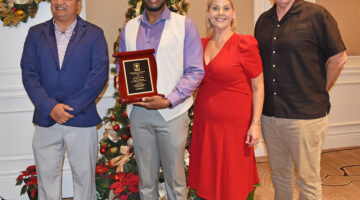Compromise offered delaying proposed Key West sunscreen ban
BY PRU SOWERS
KONK LIFE STAFF WRITER
With an unexpected surge of concerns from area residents pushing back against a proposed ban on sunscreen products containing two ingredients thought to damage coral reefs, a compromise will be offered by Key West City Commissioner Sam Kaufman at the commission’s Feb. 5 meeting.
While protecting the barrier reef six miles off-shore from Key West is everyone’s ultimate goal, how to achieve that has become a subject of controversy. While the resistance from sunscreen manufacturers like Johnson & Johnson is not a surprise, concerns raised by several local residents, charter boat captains and at least three city commissioners have put the passage of a resolution put forth by Commissioner Jimmy Weekley in jeopardy. Weekley’s proposed ordinance would ban the sale of all sunscreen products containing oxybenzone and/or octinoxate beginning a year from now. While it passed unanimously on first reading Jan. 15, Mayor Teri Johnston and commissioners Greg Davila and Clayton Lopez said they might not vote yes on the second and final reading of the ordinance until they have more scientific proof confirming the two ingredients are indeed a threat to the reef.
Kaufman plans on offering a compromise resolution that would ask the Key West Sustainability Board to look into the science behind the propose ban over the next year and report back to commissioners by Feb. 5, 2020. If then approved by the commission, a ban would go into effect Jan. 1, 2021. Kaufman said he is hoping the delay in implementing a ban would help overcome his colleagues’ concerns so that a unanimous vote can be reached when and if a new ban resolution is introduced in a year.
“A lot of good points are being made by those concerned about a lack of sunscreen to prevent skin cancer. I had the same concerns,” Kaufman said.
During the debate over the proposed ban, information came forth about other possible coral threats, including damage caused by the hundreds of tourists ferried out daily to the reef by local snorkel and scuba charter boats. Another possible contributor to the decline in reef health is chemical run-off from the Everglades caused by farm fertilizers and mainland industrial company discharge. Two representatives from Personal Care Products Council (PCPC), a trade association representing the cosmetics and personal care industry, spoke at the Jan. 15 city commission meeting and blamed warming water temperatures.
“Those other causes may be the bigger factor” as opposed to sunscreen entering the ocean after being applied by swimmers and divers, Kaufman said, adding that a one-year delay in any proposed ban would give manufacturers more time to develop more alternatives to oxybenzone and octinoxate.
“Hopefully this would give the industry, give dermatologists, give consumers that time to have more information and hopefully more UVA filters in the marketplace,” he said.
Ultraviolet A rays from the sun are what cause skin cancer. While oxybenzone and octinoxate aren’t particularly better at blocking UVA rays, they do make sunscreen application easier because they allow the cream to be absorbed into the skin, as opposed to zinc oxide, which covers the skin in a white paste that is effective but not esthetically pleasing.
Commissioner Weekley, reached by phone before the meeting, pointed out that the sustainability board earlier passed a resolution backing the proposed ban. And Weekley said he was concerned over what Kaufman wants to task those board members to do: research the sunscreen ingredient science by themselves or hire an outside consultant to do that work. However, Weekley said he “would probably support” a delay in implementing a ban.
“You have to give the [sunscreen] industry time to comply with the ordinance. I thought a year was sufficient to get the product off the shelf. But Hawaii’s ban is 2021,” he said, referring to a ban passed by Hawaiian legislators that will prohibit the sale of sunscreen products containing oxybenzone and octinoxate beginning Jan. 1, 2021.
Two separate manufacturers of mineral-based sunscreen spoke at the Jan. 15 meeting, saying there are plenty of alternative products currently available that do not contain oxybenzone and octinoxate and are just as effective at protecting against UVA rays. And while Monroe County has twice the incidence of skin cancer as the statewide average, according to the PCPC, Weekley pointed out that skin cancer rates have risen dramatically over the past several years even with the prevalence of sunscreen products containing the two disputed ingredients. He said he recently received a letter from the Panama Jack company, a sunscreen and sun protection manufacturer founded by local resident Jack Katz.
“Panama Jack would like to take a moment to acknowledge and applaud your efforts in Key West to help preserve the coral reef. This matter is important to us, and as such, we have developed a line of sunscreen products with new reef-friendly formulas,” the letter from Kim Manna, Panama Jack CEO, read.
[livemarket market_name="KONK Life LiveMarket" limit=3 category=“” show_signup=0 show_more=0]



No Comment